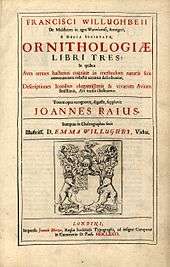Francis Willughby
| Francis Willughby | |
|---|---|
 | |
| Born | 22 November 1635 |
| Died | 3 July 1672 (aged 36) |
| Nationality | English |
| Fields | Ornithology, Ichthyology |
| Alma mater | Trinity College, Cambridge |
| Known for | Ornithologiae libri tres |
| Influences | John Ray |
Francis Willughby (sometimes spelt Willoughby)[1] (22 November 1635 – 3 July 1672) was an English ornithologist and ichthyologist.[2] He was a student, friend and colleague of the naturalist John Ray at Cambridge University, and shared some of his expeditions and interests. Ray saw Willughby's Ornithologia libri tres through the press after Willughby's sudden death.
Life and work

Willughby was born at Middleton Hall, Warwickshire to Sir Francis Willoughby and Cassandra Ridgway. He studied at Bishop Vesey's Grammar School, Sutton Coldfield and Trinity College, Cambridge.[3] In 1667 he married Emma Barnard, daughter of Sir Henry Barnard of Bridgnorth and London. They had three children. The first child, Francis, died at the age of nineteen, while his daughter Cassandra Willoughby married the Duke of Chandos, who was a patron of Mark Catesby. His second son was Thomas, who was created Baron Middleton by Queen Anne.[4]

At Cambridge Francis Willughby was taught by the naturalist John Ray. In 1662 they travelled to the west coast of England to study the breeding seabirds. Between 1663 and 1666 they toured Europe together, travelling through the Netherlands, Germany, Switzerland and Italy. They separated at Naples and Willughby returned home via Spain. On returning to England they made plans to publish the results of their studies. Willughby died from pleurisy during the preparation of this work, but Ray published Willughby's Ornithologiae libri tres in 1676, with an English edition two years later. This is considered the beginning of scientific ornithology in Europe, revolutionizing ornithological taxonomy by organizing species according to their physical characteristics. Willughby and Ray were among the first to dismiss the older inaccuracies of Aristotle. Aristotle had claimed that swallows hibernated but Willughby and Ray (1678:212, quoted in Raven 1942:328) wrote: "To us it seems more probable that they fly away into hot countries, viz. Egypt, Ethiopia etc."[5] Ray also published Willughby's De Historia piscium (1686).
In 2003 Willughby's scientific study of games was published (under the name Francis Willughby's Book of Games), making generally available for the first time in-depth descriptions of a number of seventeenth century games. It was the first such work in the English language, and is comparable to the Spanish Libro de los juegos. His early account of football is particularly noteworthy as he refers to football by its correct name and is the first to describe the following: goals and a pitch ("a close that has a gate at either end. The gates are called Goals"), tactics ("leaving some of their best players to guard the goal"), scoring ("they that can strike the ball through their opponents' goal first win") and the way teams were selected ("the players being equally divided according to their strength and nimbleness"). He is the first to describe a law of football: "They often break one another's shins when two meet and strike both together against the ball, and therefore there is a law that they must not strike higher than the ball". His account of the ball itself is also very informative: "They blow a strong bladder and tie the neck of it as fast as they can, and then put it into the skin of a bull's cod and sew it fast in". He adds: "The harder the ball is blown, the better it flies. They used to put quicksilver into it sometimes to keep it from lying still".
The Willughby family seat, Wollaton Hall is now owned by the City of Nottingham. The Willughby papers are amongst the Middleton collection held at the Nottingham University Library.
Notes
- ↑ Spelling variation of Willoughby University of Nottingham Accessed 20 May 2007
- ↑
 Lee, Sidney, ed. (1900). "Willughby, Francis". Dictionary of National Biography. 62. London: Smith, Elder & Co.
Lee, Sidney, ed. (1900). "Willughby, Francis". Dictionary of National Biography. 62. London: Smith, Elder & Co. - ↑ "Willughby, Francis (WLHY652F)". A Cambridge Alumni Database. University of Cambridge.
- ↑ Allen, Elsa G. (1951). "The History of American Ornithology before Audubon". Transactions of the American Philosophical Society, New Ser. 41 (3): 387–591. doi:10.2307/1005629.
- ↑ Egerton, Frank N. (2003) A History of the Ecological Sciences, Part 18: John Ray and His Associates Francis Willughby and William Derham. Bulletin of the Ecological Society of America 86(4):301–313
References
| Wikisource has the text of the 1911 Encyclopædia Britannica article Willughby, Francis. |
| Wikimedia Commons has media related to Francis Willughby. |
- Johnson, Joan (1981): Excellent Cassandra: The Life and Times of the Duchess of Chandos. Alan Sutton Publishing Limited, Gloucester, England.
- Poole, William (2004): The Prae-Adamitae and the early Royal Society: Two Cases from the Periphery
- Willughby, Francis (1676): Ornithologiae libri tres [in Latin]. John Martyn, London.
- Willughby, Francis (1678): The ornithology of Francis Willughby. John Martyn, London.
-
 "Willughby, Francis". New International Encyclopedia. 1905.
"Willughby, Francis". New International Encyclopedia. 1905.
